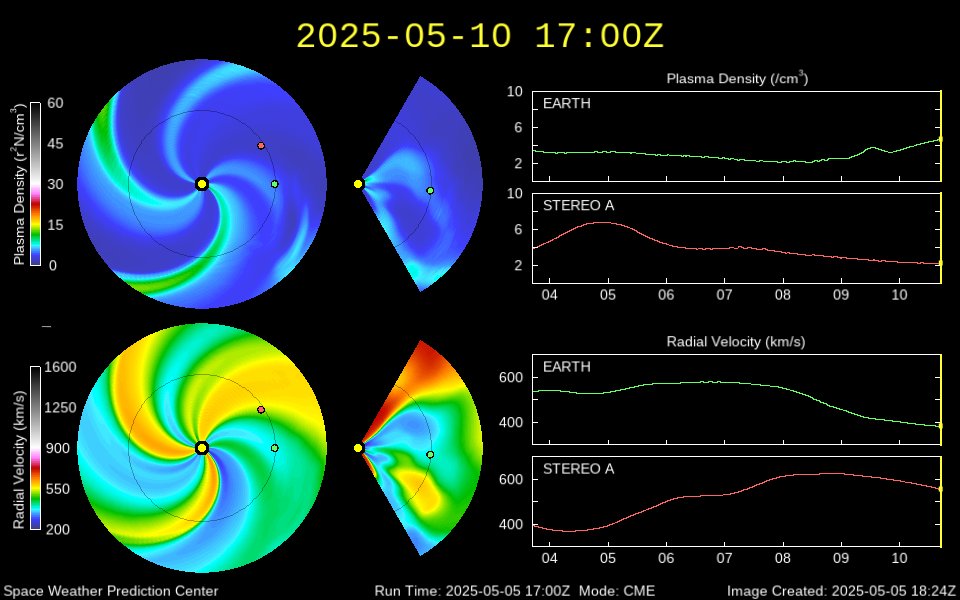
WSA-Enlil is a large-scale, physics-based model of the inner heliosphere, used by the Space Weather Forecast Office to provide 1-4 day advance warning of solar wind structures and Earth-directed coronal mass ejections (CMEs) that cause geomagnetic storms. Solar disturbances have long been known to disrupt communications, wreak havoc with geomagnetic systems, and to pose dangers for satellite operations.
The modeling system consists of two sub models: 1) Wang-Sheeley-Arge (WSA), semi-empirical near-Sun model which approximates the outflow at the base of the solar wind; and 2) Enlil, a sophisticated 3‑D magnetohydrodynamic numerical model that simulates the resulting dynamics throughout the inner heliosphere. The former model is driven by photospheric magnetic field observations made by the ground-based Global Oscillations Network Group (GONG) network of solar telescopes, combined over a solar rotation into a global synoptic map. This input is used to drive a parameterized near-Sun expansion of the solar corona, which is subsequently input into the second, interplanetary model to compute the quasi-steady (ambient) solar wind outflow. Finally, when a coronal mass ejection (CME) is detected, coronagraph images are used to characterize the basic properties of the CME, including timing, location, direction, and speed. These parameters allow for the conical representation of a CME (i.e., the “cone” model) which is subsequently injected into the pre-existing ambient solar wind structure, and the subsequent transient evolution forms the basis for the prediction of the CME arrival time at Earth, its intensity, and its duration.
In the animation, the Sun is represented as a yellow dot, the Earth by a green dot, and the STEREO A spacecraft by a red dot. The top row represents the WSA-Enlil predicted solar wind density and the bottom row the predicted solar wind radial velocity. On the left is a pinwheel plot of the ecliptic plane, showing the solar wind structures, in what is effectively an 'overhead' view. While the STEREO A spacecraft is shown, this ecliptic slice does not normally pass through the satellite, though it is typically fairly close. In the middle are meridional slices that go through the Earth, illustrating the solar wind structures from a 'side' view. The time series plots on the right, show the predicted density and radial velocity values for the location of Earth and the STEREO A spacecraft.
-
WSA-Enlil V1.0 initial model implementation on NCEP’s Central Computing System on December 13, 2011.
-
WSA_v2.2 (driven by GONG “mrbqs” synoptic maps) and Enlil_v2.6 comprised the initial implementation.
-
-
WSA-Enlil V2.0 was deployed to NCEP’s Weather and Climate Supercomputing System (WCOSS) on May 28, 2019. See the associated Service Change Notice (19-36) for details.
-
Enlil_v2.6 -> Enlil_v2.9
-
Ambient retuning: amb=a3b2 -> a8b1
-
-
WSA-Enlil V2.1 deployed on NCEP’s Weather and Climate Supercomputing System (WCOSS) on December 9, 2019.
-
Planetary ephemerides extended through the end of 2030.
-
-
GONG NRT SWx data processing transitioned to SWPC in April 2021.
-
WSA-Enlil V2.1 migrated to WCOSS2 on June 28, 2022.
-
WSA-Enlil V3.0 was deployed on April 04, 2023. See associated Service Change Notice (23-07) for details.
-
WSA_v2.2 -> WSA_v5.4
-
Implemented driving with zeropoint-corrected GONG “mrzqs” synoptic maps.
-
Implemented run-on-demand capability (retiring bi-hourly execution) for CME runs.
-
Adopted single (00Z) daily ambient run.
-
Replaced Earth data acquisition point with that of L1 point, effectively replacing contents of the “evo.earth.nc” file with that of “evo.l1.nc”.
-
-
WSA-Enlil product update on October 22, 2024.
-
Removed STEREO B from the product.
-
Adopted minor aesthetic enhancements.
-
Model output files out to 48 hours forecast can be accessed here.
The full WSA-Enlil archive is available through the National Centers for Environmental Information.